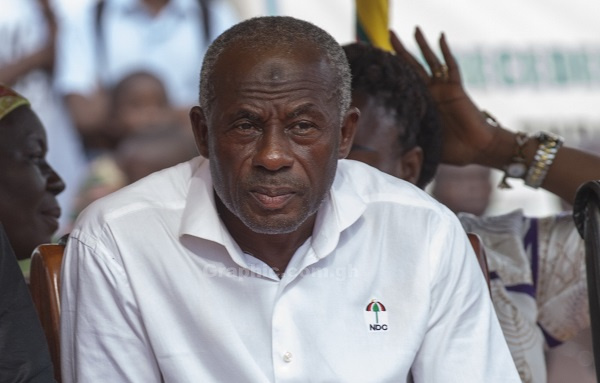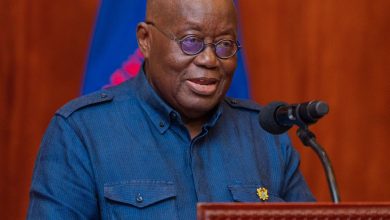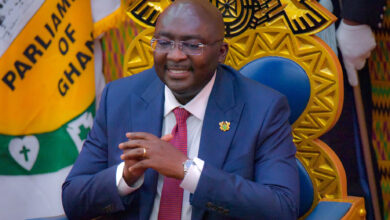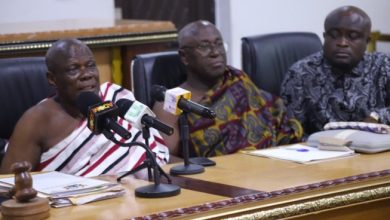Saglemi Project: Collins Dauda, 4 others in court for causing $200m financial loss to state

The National President of the Judicial Service Staff Association (JUSAG), Mr Alex Nartey, has vouched for the integrity of the Chief Justice, Justice Kwasi Anin Yeboah.
“We have worked with Justice Anin Yeboah in the courtroom, at the administrative level and at management level, and based on the moral and ethical standards with which he goes about his work, there is no way he will stoop so low to demand or take bribe,” he stated.
Speaking to the Daily Graphic in Accra last Friday, Mr Nartey expressed confidence that the Chief Justice would come out clean from the petition seeking his removal over a $5 million bribery allegation.
A private legal practitioner, Mr Kwasi Afrifa, made the allegation, but the Chief Justice had since denied it and asked the police to probe the matter.
The petition
Following the allegation, an anti-corruption civil society organisation, the Alliance for Social Equity and Public Accountability (ASEPA), petitioned the President to invoke provisions of Article 146 to commence impeachment proceedings against Justice Anin Yeboah.
A letter sent to ASEPA from the Office of the President, signed by the Secretary to the President, Nana Bediatuo Asante, said the President had commenced the processes in accordance with Article 146 (6) of the 1992 Constitution.
The letter, dated July 26, 2021 and titled: Re: Petition to invoke Article 146 for the removal of Chief Justice, said: “I write to acknowledge receipt of your updated petition in respect of the above subject matter and to inform you that the President of the Republic has, in accordance with Article 146 (6) of the Constitution, commenced the appropriate processes subsequent to being petitioned for the removal of the Chief Justice.”
Constitutional provision
The JUSAG President said the petition seeking the removal of the Chief Justice flew in the face of the Constitution.
“If you want the President to remove the Chief Justice, your petition should be right in the eyes of the Constitution. You will find out that many Ghanaians are interested in finding allegations, without finding the substance, a conduct that is a threat to our democracy.
“I don’t know who is advising ASEPA. I expect them, in the exercise of their constitutional right, to do the right thing, so that the very law that they seek to be enforced is not violated,” he said.
Explaining, he said the petition should have been sent to the President and copied to only the Chief Justice.
However, the petitioners went overboard by copying other people, he said.
Stressing that he was scandalised at the impropriety of the petition, the JUSAG head added: “So they [petitioners] are wrong ab initio.”
He cited a Supreme Court ruling in the case: Adjei Twum vs Attorney-General, Supreme Court Writ Number JI/7/2006, to back his assertion on the impropriety in ASEPA addressing their petition to other people, instead of only the President and the Chief Justice.
Mr Nartey pointed out that anybody who wanted to enforce the Constitution should not turn round to violate it.
“The petition to the President, which was copied to other persons, was wrong and in contravention of the dictates of the Constitution,” he said.
‘CJ not above the law’
The Chief Justice, the JUSAG President admitted, was not immune from questions of alleged misconduct.
However, he said, the dictates of the 1992 Constitution must not be downplayed in a matter like the removal of the Chief Justice.
Mr Nartey asserted that the Office of the Chief Justice was a constitutionally created and secure office and so the Constitution enjoined anybody who sought to call on the President to impeach the Chief Justice to follow the laid down process.
Misconstrued
Within some circles, he said, the allegation against the Chief Justice was being misconstrued to mean that he was on his way out.
“So we want to set the records straight and implore Ghanaians to dismiss the allegation,” he said.
“We have a collective duty as a people to protect the sanctity of the office of the Chief Justice,” he added.
Facts
The facts, as presented by the A-G, are that in August 2012, the then President, John Dramani Mahama, granted an Executive approval to the Housing Ministry for the construction of 5,000 affordable housing units, to be known as the Saglemi Affordable Housing Project.
The housing units, to be executed by Construtora OAS Ltd, were to be sold to workers through mortgage arrangements provided by the then Ghana Home Loans Company.
The project was funded by Credit Suisse following a parliamentary approval.
The Ministry of Finance (borrower) and the lender signed a facility agreement on January 4, 2013 for the release of $200 million to fund the construction of the 5,000 housing units, the day on which the Housing Minister also signed the EPC agreement with Construtora OAS, represented by Clocanas, the fourth accused.
According to the prosecutor, the project was to be executed in four phases on 2,172 acres of land at a contract price of $200 million, including consultancy services.
An Escrow Management Agreement, a condition precedent to the release of the facility to the borrower, was also signed, pursuant to the facility and the EPC agreements, he said.
That was among the Finance Ministry (borrower), the MWRWH (account holder), the Bank of Ghana (account holding bank) and Construtora OAS (contractor).
“The purpose of this agreement was to ensure that the $200 million facility would be properly applied towards the development of the 5,000 housing units,” the A-G said.
Per the agreements, the prosecutor said, payments were to be effected only when specific works had been duly executed, verified and certified by the consultants of the project, the Architectural and Engineering Services Ltd (AESL).
However, the EPC agreement provided for an advance payment of 40 per cent of the contract price to the contractor within five working days of receipt of the facility in the Escrow Account.
The advance payment was to be applied towards specific works set out in the contract, with the remaining amount paid to the contractor based on fulfilment of specific milestones.
“The contractor was required under the agreement to set out the details of the achieved project milestones, which had to be verified and certified by the consultants before receiving payment,” the prosecutor said.
Read also: AUDIO: Additional US$32million required to complete Saglemi Housing project
Disbursement
Credit Suisse, he said, disbursed the $198 million ($200 million less fees and transaction expenses) into the Escrow Account and the 40 per cent advanced payment to Construtora OAS effected on February 27, 2013.
He alleged that the contractor failed to apply the amount towards the intended purpose.
Review
The prosecutor said on February 27, 2014, Dauda, without parliamentary approval, reviewed the EPC agreement and signed both the original and the revised (restated) agreement with Construtora OAS, represented by Clocanas.
The revision allegedly changed the scope of works and the application of the $200 million approved by Parliament, the A-G said.
“This new agreement required the contractor to execute the project in three phases over a site of 1,272 acres, while the $200 million was now to be applied towards the execution of only the first phase of the project, comprising just about 1,502 housing units,” he alleged.
“This was contrary to the executive and parliamentary approvals, as well as the facility and Escrow Management agreements,” he added.
On December 21, 2016, the prosecutor said, the Chief Director, Yakubu, again reviewed the original and revised (restated) agreement and signed them (second and his revised or restated), without recourse to Parliament.
That led to a further reduction in the scope of works to 1,412 housing units at a revised price of $181 million and extended the completion period to July 31, 2017, the prosecutor alleged.
Subcontract
According to the A-G, the AESL, which was the consultant, on April 15, 2013 signed a contract with Vito Hugo-Coordenacao e Gestao De Projectos (VHM), subcontracting the consultancy services under the EPC for $5 million over a period of 24 months, the amount provided under the EPC agreement.
While the AESL was to take $2 million, VHM was to be paid more than $2.98 million for its services.
According to the facts, in April 2015, while both companies were still providing consultancy services under the contract, the MWRWH entered into another contract for consultancy services with Ridge Management Services Solutions DWC-LLC (RMS), represented by the director and majority shareholder, Tetteh Angelo (the fifth accused), for three months for a contract sum of $5.6 million.
“This was at a time RMS was not registered in Ghana as a company. Once again, the MWRWH was required to make an advance payment of 40 per cent of the contract sum,” the facts said, adding that it was also outside the EPC agreement.
The prosecutor said the investigations revealed that Angelo, the majority shareholder of RMS, was also a Director of VHM Ghana Ltd.
He said Agyeman-Mensah, in August 2016, again entered into another agreement with RMS, referred to as “marketing implementation services”, for the sum of $2.5 million, with the ministry required to make 40 per cent advance payment.
“All this while, the AESL and the VHM were purportedly performing the same consultancy services for the project, their agreements having been extended at various times by Dauda and his successor, Agyeman-Mensah,” he said.
Payment for no work
The prosecutor further alleged that between March 2014 and January 2015, the government paid $46.13 million to the contractor, Construtora OAS, while $3.38 million was paid to the consultants, the AESL and the VHM, when no work had been duly executed.
“These payments were authorised and approved by the 1st and 3rd accused without any evidence of specific project milestones achieved by the contractor, as required under the EPC agreement,” he alleged.
Similarly, there was no justification for an $80 million payment earlier made, the prosecutor further said.
Again, he alleged, $54.1 million was okayed by Dauda and Yakubu and paid to the contractor between June 2015 and January 2017, with evidence of works and milestones achieved.
The prosecutor alleged that payments made to the AESL, the VHM and the RMS were far in excess of the $5 million stated consultancy fees and without evidence of work done.
Arraigning
It is not clear when the accused persons will be arraigned, as the courts are expected to resume from legal vacation in October this year.
If they are arraigned within the legal vacation, the accused persons will appear before a vacation judge. These are judges who are made to stay on and work so that the legal system will not go to sleep during the vacation period.
Since a vacation judge does not deal with substantive issues, the accused persons will only be in the vacation court for their pleas to be taken, apply for bail or for remand purposes.





